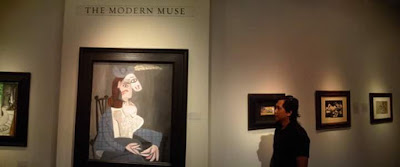In the
old days, many artists would argue that the best way to find art collectors is
by meeting them in person. However, now people are selling work more and more
without ever seeing their buyers. In fact, they sell their work without so much
as leaving their house. That is the power of the internet.
When
you’re just starting out, it’s important not to spread yourself too thin.
Concentrate your energy on the sites that will get you the right audience.
There are many social media sites (Facebook, Twitter, Instagram, Pinterest,
Google+, Tumblr., LinkedIn – just to name a few), but you should only focus on
1-2 of these when you’re getting started.
The ABCs of Social Media Sites
When
picking which social media platform you’ll be promoting your work on, consider
three things: audience (who is using the site?), behavior (does the site allow
you to interact easily with your audience?), and content (what kind of things
are typically shared on this site?).
Audience: Just as every artist has their
own style, their works also attract different audiences. Your audience may use
Instagram more often, while another artist attracts the sort of people who use
Pinterest. First, you’ll need to know your market, then you’ll want to know the
main users of the social media platforms. You can learn what kind of audience
you have by showing your work in more public spaces and seeing who reacts more
strongly to it, or by looking into the audiences for similar artists.
Important: While young adults are still
the largest group to use social media, other generations are catching up very
quickly. According to Pew
Research Center, over
35% of adults 65 and older are using social media, compared with only 2% in
2005.
Behavior: As an artist, you’re looking
for several things when choosing a platform. You want to pick a social media
site that allows you to share images easily. You want a platform where it’s
easy to communicate with the viewers of your work, and one where you can link back
to your personal website.
Content: Whatever social media platform
you choose, it should be a place where it is common to share artwork. If you
are the first person to start selling art in a new marketplace, you do have the
element of originality, but how many collectors will be there to see it? You
want to be sure that this is a place where collectors are actively looking to
find art.
Facebook: Possibly the most popular site
with 1.44 billion monthly active users, Facebook allows people to share text,
photos, videos, and external links. Facebook is a very engaging platform,
encouraging comments and reactions to posts. There are also communities on
Facebook in which users can collaborate and share specific, moderated content.
Instagram: A great image-sharing tool,
Instagram has recently allowed users to upload photos that break away from the
restrictive square-only format. Obviously, due to its visual-intensive nature,
Instagram is a wonderful platform to upload your artwork and get immediate
feedback from the global Instagram community.
Twitter: With 305 million monthly active
users, Twitter is most often used for text-only updates (though users do
occasionally post images, videos, and links). Each post is a maximum of 140
characters. Though the audience is mostly younger and international, Twitter is
not very popular for fine artists or collectors.
LinkedIn: LinkedIn is far more
business-oriented than any other social media sites. Due to its professional
nature, you may find some art collectors here, but the content typically shared
is about industry news – not artwork. Soliciting your artwork on LinkedIn would
likely be frowned upon by serious collectors, though you can use LinkedIn to
join communities for artists where you can learn about resources and events in
the fine art ‘industry.’
Google+: Google attempted to break into
the social media world, but it was difficult to do with so many established
giants. With an estimated user base of just 5 to 6 million, Google+ is a
smaller network, but its users are very loyal to the network.
Snapchat: Originally more of a personal
communication app, Snapchat is a social media app in which you can send
pictures to specific recipients. However, those photos are deleted permanently
after a few moments. The market is much younger, on average, than most others.
While a fun app to share images with, Snapchat is not ideal for selling
artwork.
Tumblr: A very versatile platform,
Tumblr. allows users to highly customize their pages, to which they can post
anything from text to images to short videos. Tumblr. has a strong ‘community’
feel, encouraging a lot of engagement with audiences. However, be aware that
this growing platform is still very small, and the audience is much younger
than others’.
Pinterest: The audience for Pinterest
seems like a perfect place to find collectors, as its users are designers,
DIY-enthusiasts, and home decorators. However, Pinterest is not a very “social”
social network – there is not much commenting or interaction between users,
meaning your fans may never get in touch with you about the artwork they
like.
Though
there are many social media sites out there, especially location-specific ones
like Asian sites Renren and Sina Welbo, these sites are the ones you’ll most
need to know about.
Unless
you have a strong reason to suspect one of these websites will have particular
advantage for you, the two best websites for artists to start promoting their
work to collectors are Facebook and Instagram.
Info: www.agora-gallery.com











No comments:
Post a Comment